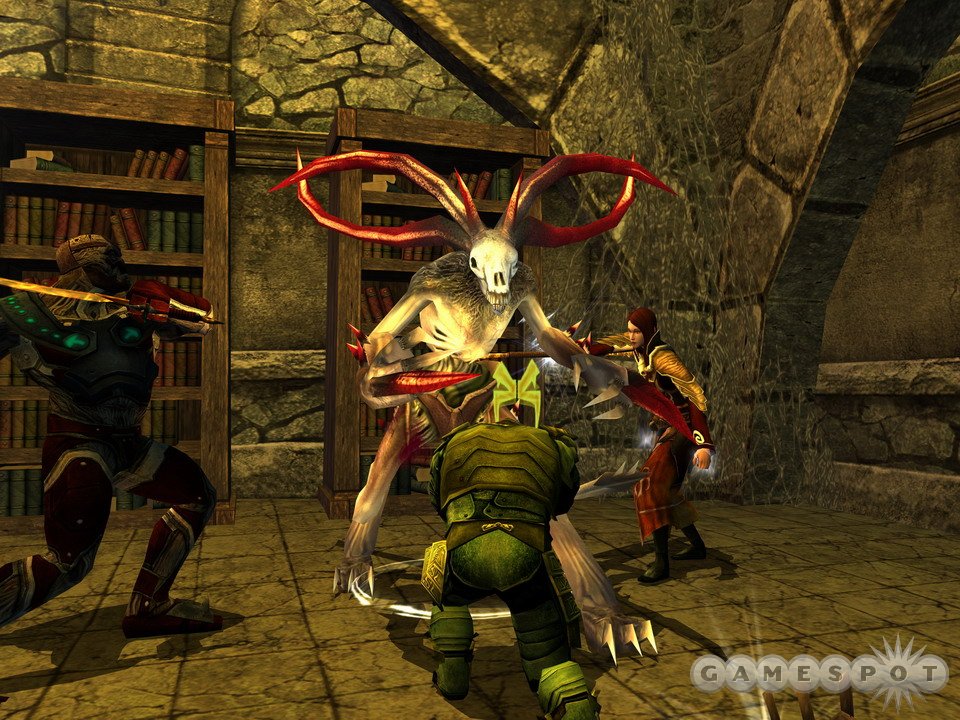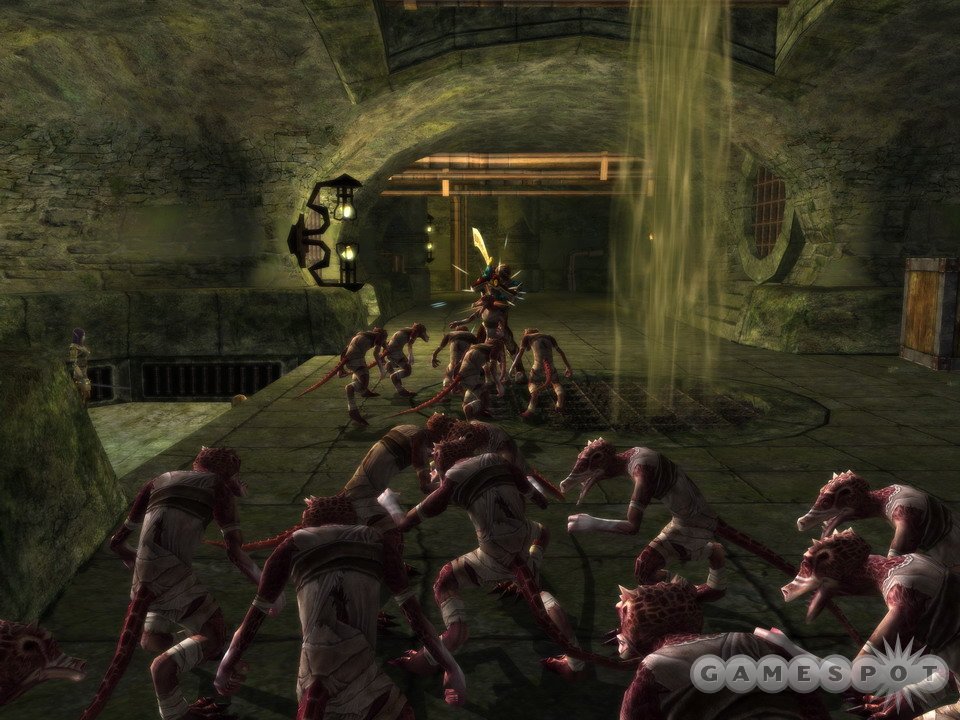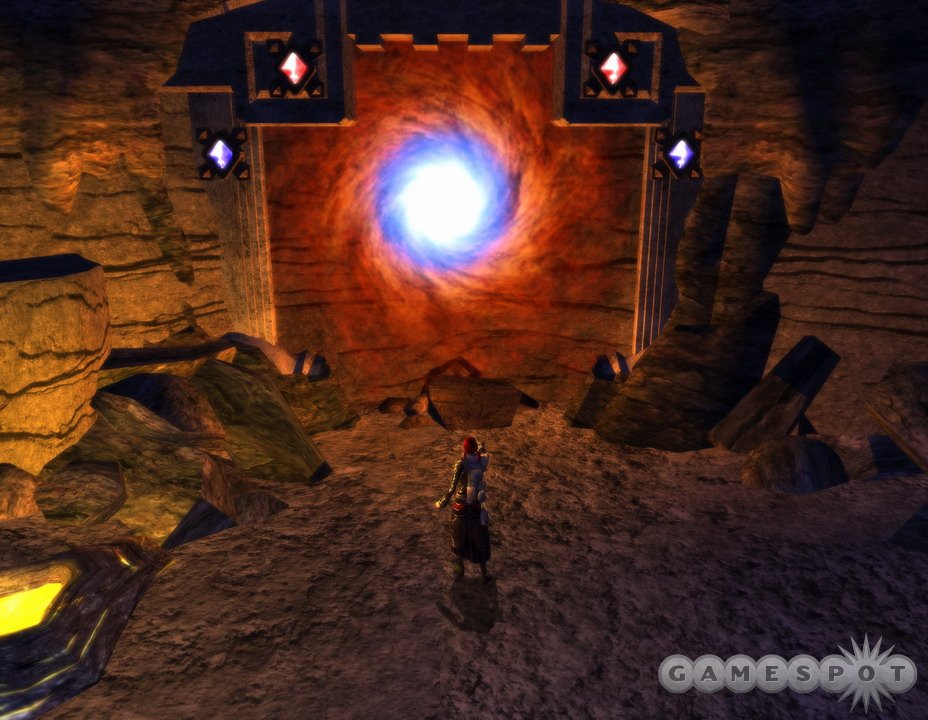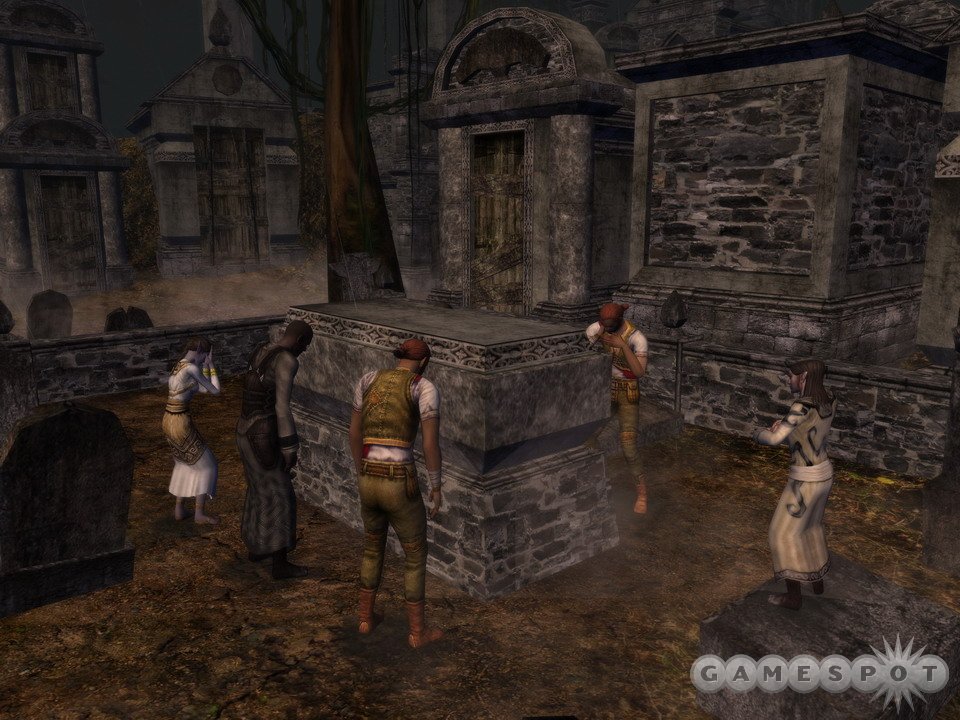Dungeons & Dragons Online: Stormreach Designer Diary #3 - Putting D&D Into Online RPG
Turbine's Sean Lindskog tells us how Dungeons & Dragons Online will put an emphasis back on role-playing and adventuring.
With online role-playing games hotter than ever, making a Dungeons & Dragons-based online role-playing game may seem like an obvious idea, yet we've had to wait years for that idea to take shape. Now, Turbine is working on Dungeons & Dragons Online: Stormreach, a game that will let you adventure in the D&D campaign world of Eberron. Translating the pen-and-paper experience of D&D into a virtual experience, however, isn't as simple as it sounds. The task of doing this fell partly on Sean Lindskog, Turbine's lead content engineer. The conversion process started with seven major design goals, which he explains in our latest designer diary.
Putting D&D Into Online RPGs
By Sean LindskogLead Content Engineer, Turbine
It's no easy task to build a massively multiplayer game that lives up to the Dungeons & Dragons name. Players of the pen-and-paper D&D game surely have vivid memories of many an epic adventure. This was our challenge for DDO--how can we re-create this feeling in an online game?
Early on in DDO's development, we outlined some high-level goals for the player experience.

The first design goal was to create the ultimate dungeon crawl. I'm really fond of the old first-edition Advanced Dungeons & Dragons modules. The centerpiece of many of these was a bunch of interconnected rooms, each with some deadly menace awaiting your arrival. It might have been a cavern, a labyrinth, a tomb, or a castle, but it probably had a bunch of rooms, passageways, and little numbers, which the dungeon master used to look up room descriptions and secretly plot your demise. Ahh, good times! No D&D game should have anything less than an incredible dungeon crawl.
The second design goal was Xen'drik and the city of Stormreach. In DDO, we have the unique opportunity to forge a corner of the new campaign setting of Eberron. We wanted both the urban setting of Stormreach and the excursions to the surrounding territory to inspire great adventures.
The third goal was quest-based advancement. We didn't want to create a world where players spend hours on end "camping a spawn" and grinding through levels. Your advancement should be driven by the quests that you're on. Leveling should feel like a side benefit to playing a fun game, rather than a chore.
The fourth design goal was to have fun with parties. D&D is very much about a shared experience with your friends. This isn't to say we purposely designed against solo play. It's just that our main focus was on a good party (group) experience.
The fifth design goal was to create handcrafted, story-driven content. We wanted the game to feel as if the DM was personally crafting the experience for you and your party. Autogenerated content (either dungeons or landscapes) seemed wrong for a game whose roots are in storytelling, imagination, and narration.
The sixth design goal was to get you into the action fast. While worlds with huge landscapes can seem realistic and cool, it can be pretty frustrating if that landscape is empty or if you need to travel for half an hour to get to something fun.
And the seventh design goal: Live your character. We decided not to make a game that simply allowed people to play pen-and-paper D&D over the Internet. Instead, we wanted to bring all the best things of D&D, video games, and online role-playing games together. When you're playing DDO, you're not leisurely rolling dice to attack your opponent with a soda in one hand and a slab of pizza in the other. You're highly immersed in a tense, real-time situation where every second counts. This design goal affected combat even more than content, but it was certainly a concept we embraced content-side. We wanted the game to feel visceral.
Putting these design goals together, we came up with a quest system that can be described like this: DDO uses instanced, party-based adventures in fantastic settings imbued with intrigue and visceral danger. Quests behave like story arcs that encompass one or more adventures and are delivered via colorful non-player character dialogue, the quest journal, and an actual DM narrative. Leveling relies solely on quest-based advancement.
I'd like to break this down and talk about the pieces.

What's a fantasy story without a fantasy setting? We created a thriving city with smoky taverns, majestic towers, and monster-infested sewers. We created fire-lit dungeons, ancient ruins, deep caverns, undead catacombs, haunted mines, thick jungles with hidden paths, suspended bridges, rivers and waterfalls, thunderous mountainous regions dotted with caves and tunnels, volcanoes bursting with molten lava, abandoned keeps, pirate ships, temples to dark gods, and, of course, dragon lairs.
We also needed danger, challenge, and reward. We created a host of monsters, traps of all varieties (spikes, swing-blades, darts, poison, acid, and fire, many with exposed mechanisms to disable them--given nimble fingers and some thieves tools), magical runes and mystical gateways, secret doors, levers, drawbridges, patrol routes and dark shadows for stealth, locks and lock picks, arcane puzzles and mechanisms, treasure chests, and a myriad of magical armor, weapons, wands, potions, and scrolls.
Then we needed to populate the world with interesting NPCs. Many are just for flavor--content to remark on whatever rumors or musings strike their fancy. Others have full-on interactive dialogue, bestow quests, and converse at great lengths on the troubles besieging the land.
Instanced Adventure
Now we get to instances, or a section of the world, such as a dungeon, that is created as many times as needed to give each player or groups of players their own version of that space. In a noninstanced space, it's difficult (design-wise) to permanently alter the monsters or the environment. Most current examples of noninstanced spaces in online role-playing games restore themselves. Monsters respawn and objects replenish, and so you can't really change anything with any permanence. This is necessary because as players continually cycle through the area, they all must have a chance to play the content. 
Unfortunately, this noninstanced layout isn't so hot for creating good quests. It isn't very heroic to embark on a quest to steal into a dungeon and rescue some prisoners, only to find the guards already dead and a line of other players waiting to rescue the prisoners--that is, once they finally respawn. You can create a far greater sense of immersion with instanced spaces. The area will be untouched (and uncamped) by other players. You can allow far more environmental challenges and interactions (for example, raising and lowering drawbridges or unleashing a demon from its magical constraints to terrorize its former captors). You can create far more progression toward an ultimate goal and weave in a narrative element that wouldn't be possible in a noninstanced space.
The party-based adventure's design goal also had a profound impact on the architecture of our quest system. Whenever players are in any kind of dangerous territory, they are on an adventure. An adventure is an instanced area that contains a series of objectives, which the party needs to solve. All players in the party share the same objectives. This is unlike most other online role-playing games, where players might be on totally different quests (or no quest at all) while grouping together. Only players in the same party can enter the same adventure instance.
The goal of an adventure, of course, is to accomplish objectives. Objectives can be any kind of measurable action, such as killing a monster, acquiring an item, destroying an object, arriving at a certain place, speaking with an NPC, or interacting with other dungeon entities. In many adventures, the objectives are initially hidden and unfold as you progress. Adventures often include optional objectives along the way. Optional objectives sometimes require you to use a unique skill or ability to overcome them. This allows players to use their characters in some pretty cool ways to overcome these challenges. For example, optional objectives may be gated by creating doors that can only be unlocked with certain skills or by using a certain spell; runes that can only be activated by players with high intelligence; and so on. Adventures provide our quest designers with the tools to create specific, interesting challenges beyond the typical hack-and-slash style of gameplay. And the members of the party contribute by using their unique skills to help overcome these challenges.
To guide players along, the quest journal, along with NPC dialogue, delivers much of the overarching plot of the DDO story. Quests are solved in stages. Simple quests may only have a couple of stages. Complex quests may have a dozen or more. Each stage is advanced either by speaking with an NPC or completing an adventure. The history of your accomplishments, along with your next goal, is recorded in your quest journal. Delivering a strong overall plot is as important as the action elements, and the quest journal plays a key role in this.

The dungeon master narrative is injected into the game via "DM text," which gets written onto the screen at key moments of the adventure. The DM text allows a much more literary description of the story than would otherwise be possible. DM text can also deliver skill-based information, such as quiet noises (to players with a high listen skill), subtle visual details (to players with a high spot), or translations of mystical or ancient runes (to players with the appropriate ability to decipher such writings).
In order to reinforce the idea that quests are the heart of DDO, we only award experience for completing adventures or defeating encounters while traversing some of the dangerous paths of Xen'drik. There is no experience granted per kill in DDO! This is a radical departure from conventional online role-playing game design. It cements quests as the core of the gameplay and rewards ingenious players, exploration, and camaraderie.
For any of you who got this far, thanks for reading! I'm really excited to be part of such a great project and look forward to throwing open the gates for all you daring adventurers!
Got a news tip or want to contact us directly? Email news@gamespot.com
Join the conversation